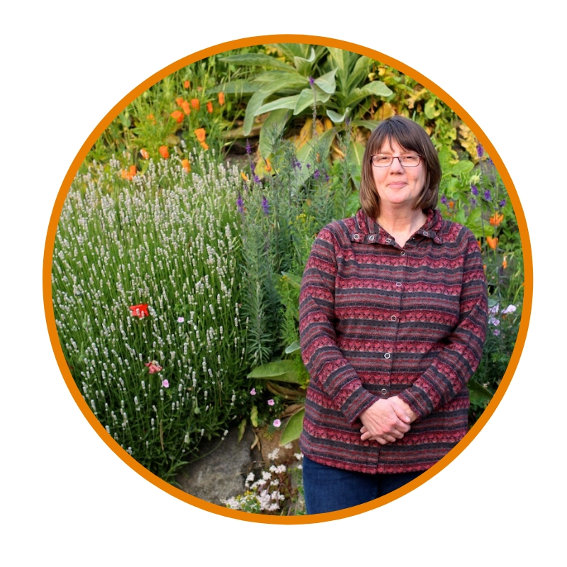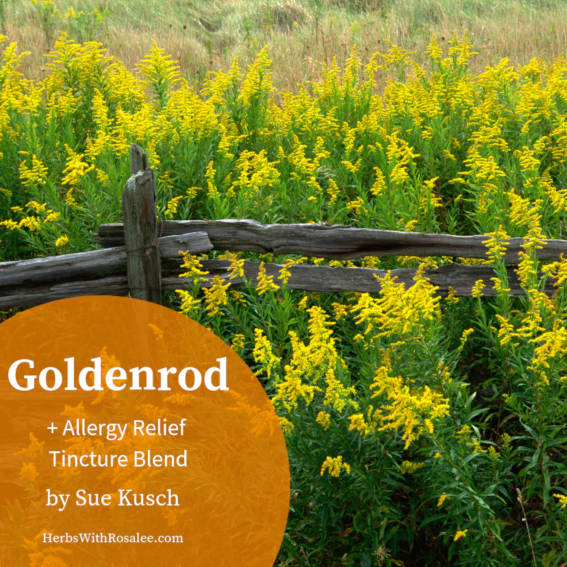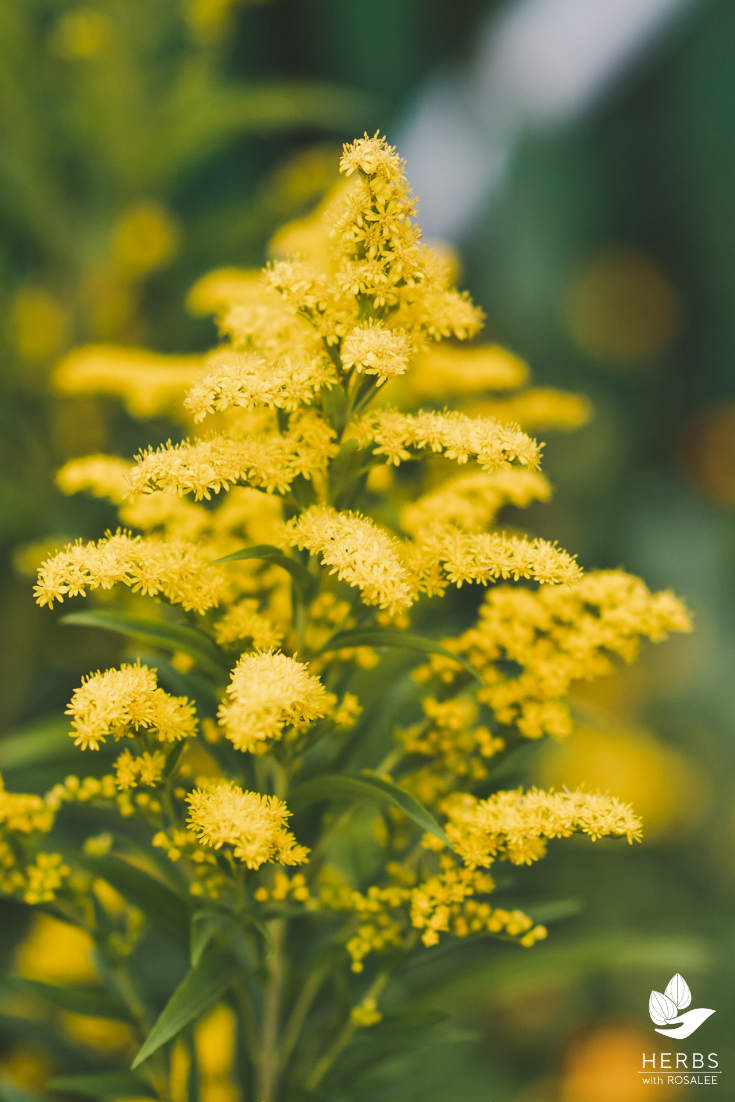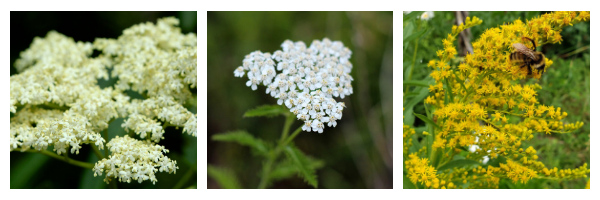Get weekly tips, recipes, and my Herbal Jumpstart e-course! Sign up for free today.

Information About Goldenrod
Share this! |
|
We all know about those love-hate relationships: alternating bouts of emotions in which one moment we are happy with someone/something and the next moment we are less than happy with them. A gardener often has multiple love-hate relationships happening: unrestricted bamboo, the staining fruits of a mulberry tree planted next to a patio, adorable gophers who eat our veggies, and any plant put in the "wrong" place. My current love/hate ordeal is with the allelopathic and over-enthusiastic reproductive bully, Solidago canadensis, commonly known as goldenrod.
Found in every state and province of North America, goldenrod’s seventy-seven species qualify it as a native genus but there are a few native Solidago species in South America and seven in Europe and Asia. Habitats, bloom times and current status (threatened, endangered) vary widely among the species and many regions host multiple species. Check your regional plant guides to know which goldenrod species live in your area but be forewarned that the identifying down to the specific species can be challenging for the home herbalist. There are similar-looking plants that bloom during the same time, and some are toxic so using a regional plant guide will help ensure that you have actually found goldenrod.
In my neck of the Pacific Northwest woods, my native goldenrod is S. canadensis, which can be found in all of North America except in a few southern states. A late-summer bloomer, its tall yellow spires of tiny composite flowers are easy to spot in abandoned fields, on the edge of woodlands and in roadside ditches. I didn’t encounter many goldenrod plants within walking distance of my rural home so that inspired me to cultivate my own patch of it.
Information About Goldenrod: Relationship Giddiness
Like many new relationships, I became excited as I first discovered the numerous benefits of growing goldenrod in my herb garden:
- Bright cheerful flowers that attract a diverse number of native bees, beneficial wasps, butterflies, spiders, praying mantises, ants, and moths.
- As a late bloomer, goldenrod is one of the last floral sources of nectar and pollen for pollinators (they need all the help we can offer).
- Allergy relief: Goldenrod has been falsely accused of causing allergic reactions so it is a bit ironic to learn that it actually offers relief from seasonal allergies. I have included my recipe for a tincture blend that I use every spring at the end of this article.
- Muscle ache relief: I infuse coconut oil with goldenrod flowers and use it on sore muscles.
- Goldenrod is reported to have a high level of antioxidants, so I harvest and dry barely opened flowers for tea to drink throughout the winter.
- Traditionally, goldenrod has been used to nourish the urinary system and to address urinary tract infections. Modern research suggests that European goldenrod can significantly reduce chronic irritable bladder conditions.1
- As a native North American plant, I was curious about how indigenous people use goldenrod. In Moerman’s Native American Ethnobotany, he lists many diverse uses by individual Solidago species and by native people groups.2 Some of the cited uses for S. canadensis include fever, diarrhea, and pain relief. Interestingly, the root is mentioned for several remedies but modern herbalists have not offered similar recognition. Many of the uses are indicated for babies and children, which suggests that it is considered a gentle and effective remedy.
- As a natural dye, goldenrod produces various hues of yellow and green, depending on mordant and fiber used.3 Goldenrod was my first attempt at dyeing wool yarn, and it was easy to do with a wonderful result.
Information About Goldenrod: Relationship Woes
In my excitement about the benefits of growing goldenrod plants in my garden, I apparently missed warnings like this from the USDA Plants database:4
Canada goldenrod is not typically planted in a landscaped setting due to its spreading rhizomatous growth. However, it is possible to manage plants by planting in a pot submerged in the ground, or by removing new growth each year. Seed dispersal can be controlled by removing flower heads prior to seed ripening.
And this one:
Goldenrods have a reputation of being weedy due to their aggressive rhizomatous growth.
Gardeners are known for their bleary-eyed optimism as well as their
profound ability to disregard common-sense advice and botanical
realities (Don’t ask me how many rosemary plants I have tried to
overwinter in USDA Zone 6).
I decided that goldenrod would look wonderful in my medicinal flower bed, which hosted several species of bee balm, echinacea, yarrow, foxglove, and lavender.
In its first year, it did look lovely planted on the edges of the
garden. During its second year, my foxglove barely returned, and I had
less bee balm. By its third year, it had consumed half of my flower bed
and now, year five, it is the only plant in my medicinal flower bed.
You might be asking where I was while this aggressive takeover occurred? In denial. Another behavior found among some gardeners. Like some relationships, perhaps I thought I could change goldenrod’s behavior. Or choose to ignore it and the behavior would go away (for future reference, I tried this last strategy for several years while watching gophers fatten up on my garden vegetables...it was not a successful strategy).
Information About Goldenrod: What is Allellopathy?
I watched the rhizomatous growth creep through my garden bed but I didn’t fully understand why my other plants did not return. More research revealed that goldenrod roots produce chemicals that reduce and prevent germination of other plants, a process called allelopathy. Allelopathy is being studied by complex science to understand how individual species employ this strategy. In particular, the agricultural industry is interested in the use of allelopathic chemicals as a replacement for synthetic herbicides.5
There are several invasive or aggressive plants in the herbal garden - peppermint and spearmint are well known for their insistence on occupying all of the immediate real estate. Others like lemon balm, comfrey and wormwood will gladly distribute their seeds if allowed to.
Of course, I don’t actually hate goldenrod and I am not going to break up with it because it truly is a welcome herb in both my garden and my apothecary. But it’s clear that goldenrod needs its own space and lots of it. This fall, my relationship with goldenrod will change, and I will honor its preferences. I will be digging up my thicket of goldenrod and moving some of it to a sunny section of my pasture that mostly grows knapweed and chicory so I would be more than happy to see goldenrod replace them.
I also intend to guerilla-share some of my goldenrod with the clearcuts that surround my property, which are mostly devoid of native herbaceous plants. S. canadensis is native to my bioregion and will be less aggressive because its pampered days of rich garden soil and regular irrigation are over.
I have known for decades that growing plants is full of lessons about life and living. Working side by side with Mother Nature teaches humility and inspires respect and awe. Relationships are always good for growing wisdom if you listen to the lessons.
Information About Goldenrod: Allergy Relief Tincture Blend
A gardener with seasonal allergies is an unhappy gardener. I developed acute seasonal allergies in my 30s and dreaded spring each year. My study of herbal medicine led to a major diet improvement and herbal support for my liver and the severity of my symptoms was reduced dramatically. Still, each spring the grass pollens get me - especially since I am outside so much. I dislike the over-the-counter (OTC) options so turned to herbs. I have been using this blend for several years to eliminate the annoying nasal drip and congestion. The best part is there are no side effects like OTCs have.
Goldenrod Recipe: Allergy Relief Tincture Blend
- 1 part elder flower tincture (Sambucus cerulea. S. nigra)
- 1 part yarrow tincture (Achillea millefolium)
- 1 part goldenrod tincture (Solidago spp.)
Blend together and store in a glass bottle. I use drops of this throughout the day so a dropper cap is preferred.
I recommend making a minimum of 4 ounces or more since you will use it many times a day for several weeks. I take a dropperful every hour or two. I also protect myself from pollen exposure: I work outside early in the morning, I rub the inside of my nose with cottonwood salve (because I love the smell) before going outside and, if the pollen is heavy, I take a shower immediately after I am done outside.
In my experience, this works best with mild nasal congestion and is especially effective at eliminating drippy tissues. If your symptoms are more severe you may want to work with a clinical herbalist to see what other strategies you can use.
Information About Goldenrod Citations
1. Veitch, Nigel C., and Carol A. Newall. Herbal Medicines. London: Pharmaceutical Press, 2013.
2. Moerman, Daniel E. Native American Ethnobotany. Portland, Or.: Timber Press, 2010.
3. “Goldenrod (Solidago Spp).” Dyeing with Goldenrod | Wild Colours natural dyes, n.d. http://www.wildcolours.co.uk/html/goldenrod.html.
4. “Welcome to the PLANTS Database: USDA PLANTS.” Welcome to the PLANTS Database | USDA PLANTS, n.d. https://plants.sc.egov.usda.gov/java/.
5. Ferguson, James J., Bala Rathinasabapathi, and Carlene A. Chase. “Allelopathy: How Plants Suppress Other Plants.” EDIS New Publications RSS. Horticultural Sciences, August 26, 2016. https://edis.ifas.ufl.edu/hs186.

Sue Kusch, a former community college instructor and academic advisor, incorporates her experiential wisdom, expertise and science-based research garnered from her three decades of growing vegetables, fruit and herbs into her educational writing about plants and how people use them. In addition to her BA in Social Sciences and Masters in Education, she completed the Master Gardener training in 2011 and two permaculture courses in 2001 and 2014. She has studied medicinal and nutritional uses of herbs, including studies at Herbmentor and East West School of Planetary Herbology, since 1997. An avid reader, lover of historical and folkloric information, and a promising storyteller, Sue writes about the intersection of plants and people.
Return from Information About Goldenrod to the Main Goldenrod Plant article
Return from Information About Goldenrod to HerbalRemediesAdvice.org


